
Pafos Zoo is a very nice place to spend a lovely time, with or without kids. It has beautiful trees and flowers, lots of different animals, a real bird show and it houses 3 popular museums! Worth a visit.


I love to go to zoos in different countries, as they usually tell a lot about the national culture. Pafos Zoo in Cyprus tells us that they deeply care about nature, animals and cultural traditions. This Zoo finds a way to bring animals close to human beings while still very thoughtful about animal welfare. Although the day I visited was a very hot day, Pafos Zoo is made in a way that it made the heat more bearable.




Animals vary from snakes and the amazing frog you see on top, rhinoceros, austriches or lions, they are all there. One of Pafos Zoo’s specialties are birds. Many species from all over the world, in all colours, like these 2 birds from China. Photographing was difficult because of the wire but in reality you see them very clearly, better than on the photos.


I was thrilled by the bird show, where they show many birds very close to the public, most birds only shortly and with strict instructions to the public. Lots of educational stuff in this show too, all presentations in English. The owls were particularly amazing!

The three museums are small and very interesting. Just the right size and amount of object to keep zoo-visitors interested and informed. Going there along the paths is a joy as everything is so well taken care of.



Indirectly these museums tell about the moving history of Cyprus, for example pottery in the Traditional Art Museum. You’d think, ah, they show some pottery of the (near) past. But the dates matter.
Here is a collection of Canakkale (Tsanak Kale) pottery until 1922. Canakkale is in actual Turkey, on the coast, where terrible fighting took place in WO1. After 1922, Greek communities in Turkey and Turkish communities in Greece were ‘exchanged’ in an attempt to create mono-ethnic countries and end ethnic fighting. So that’s where the Greek pottery of Canakkale stopped….
There is also a collection of Lapta (Lapithos) pottery until 1974. Lapta lies on the northern, now Turkisch-Cypriot side of the island. The Turkish army took over on that side in 1974 and the Greek Cypriots fled to the southern, now Greek-Cypriot side. So that’s where the Greek pottery of Lapta stopped…
The tragedy can be reconstructed by the attentive visitor only, as there is no explanation in words. A moving history full of loss.


In the Clothing Museum they show the different wedding clothes of Turkish Cypriots and Greek Cypriots. of urban Cypriots and Village Cypriots. These are clothes from an island where differences existed since many centuries. It was not ‘peace on earth’ all the time but they did not need a wall to keep ethnic groups away from each other. Also quite moving!



So you understand, I highly recommend a visit to Pafos Zoo. It is a bit off-site, way out of town so a car would help. There is a bus leaving from Pafos center but I didn’t test it. It’s worth the trip as you can easily spend some hours there – they even have a nice restaurant. The fact that it is off-site gives the Zoo and animals and nature space – the air is pure and the atmosphere is lovely!
You may also like
Zoo Gaziantep: lions, camels, cows
Majete Wildlife Reserve in Malawi: unknown beauty


 the sign to remember that moment is still on the wall inside the church (see the photograph on the right). In 1974 the Island of Cyprus was divided in a Northern and Southern part. The Greek Cypriots inhabitants of the village that then was called Stylloi, went to the South while Turkish Cypriots who lived in Mouttagiaka / Mutluyaka, an old Osman village in the very South of the island, resettled in Stylloi in the North and renamed the village of Stylloi after the village they left.
the sign to remember that moment is still on the wall inside the church (see the photograph on the right). In 1974 the Island of Cyprus was divided in a Northern and Southern part. The Greek Cypriots inhabitants of the village that then was called Stylloi, went to the South while Turkish Cypriots who lived in Mouttagiaka / Mutluyaka, an old Osman village in the very South of the island, resettled in Stylloi in the North and renamed the village of Stylloi after the village they left. As the church of Saint Helias is quite new, there is not a lot to tell about it. The amount of concrete used is too big to call it ‘lovely’ like many other Greek churches still are. Inside, it was stripped of almost all objects, as you can see in the photograph I took.
As the church of Saint Helias is quite new, there is not a lot to tell about it. The amount of concrete used is too big to call it ‘lovely’ like many other Greek churches still are. Inside, it was stripped of almost all objects, as you can see in the photograph I took. 
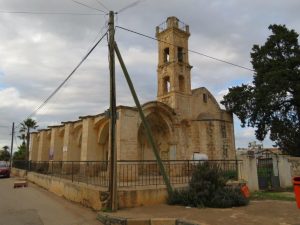
 at the main porch.
at the main porch. On the front side of the church, both the
On the front side of the church, both the  Turkish and the Turkish Cypriot flag were present which could indicate some kind of actual use. Alternative activities are not necessarily a disadvantage for a building, although I know that it is hard for Greek Cypriots to see their heritage used for other religious or nationalist purposes. When it comes to preservation, in Northern Cyprus churches that have been used or are still used, often show a much better state of affairs than empty churches that fall into the hands
Turkish and the Turkish Cypriot flag were present which could indicate some kind of actual use. Alternative activities are not necessarily a disadvantage for a building, although I know that it is hard for Greek Cypriots to see their heritage used for other religious or nationalist purposes. When it comes to preservation, in Northern Cyprus churches that have been used or are still used, often show a much better state of affairs than empty churches that fall into the hands  (feathers and dirt) of birds, rain and wind. Empty and deserted churches (since 1974 = for decades) have step by step fallen into decay – here are
(feathers and dirt) of birds, rain and wind. Empty and deserted churches (since 1974 = for decades) have step by step fallen into decay – here are 
 mality, the field-like aspect of the place. That spot looks like ‘the middle of nowhere’ and everybody knows nothing happens in the middle of nowhere. So how did these heavy things occur right here? It would be reassuring if a place where very bad things happen, had some kind of special sign or mark. But
mality, the field-like aspect of the place. That spot looks like ‘the middle of nowhere’ and everybody knows nothing happens in the middle of nowhere. So how did these heavy things occur right here? It would be reassuring if a place where very bad things happen, had some kind of special sign or mark. But there is none. Of course now
there is none. Of course now  there is a monument and a man made statue in the former mass grave. Information boards tell visitors that abnormal activities took place here; but this information board is broken. Somehow, remembering does not seem to be serious business. It really irritates me to find broken information boards in memorial places like this, like I wrote in the
there is a monument and a man made statue in the former mass grave. Information boards tell visitors that abnormal activities took place here; but this information board is broken. Somehow, remembering does not seem to be serious business. It really irritates me to find broken information boards in memorial places like this, like I wrote in the  ‘this monument was erected in memory of these 37 martyrs who did not flee from their village, and defended the honor of the Turkish flag on the cost of their lives‘. I found it difficult to read this text neutrally.
‘this monument was erected in memory of these 37 martyrs who did not flee from their village, and defended the honor of the Turkish flag on the cost of their lives‘. I found it difficult to read this text neutrally. serves as Şehitler Müzesi, the Martyr’s Museum for Murataga, Sandallar and Atlilar where massacres took place in 1974. I passed this museum by surprise, on my way from the
serves as Şehitler Müzesi, the Martyr’s Museum for Murataga, Sandallar and Atlilar where massacres took place in 1974. I passed this museum by surprise, on my way from the 
 There had always been some pressure on the Turkish Cypriot children but the heavy troubles of 1958 chased all Turkish Cypriot children away and forced the last Turkish Cypriot inhabitants of Pigi Peristerona to leave and move to the smaller village of Murataga (in Greek: Maratha). Murataga welcomed the ‘refugees’ and built houses for them. At that time also a school and a mosque were made. Who could imagine that on August 14, 1974, 29 children (their names are in the picture) of that school would be killed, bulldozered and buried in mass graves?
There had always been some pressure on the Turkish Cypriot children but the heavy troubles of 1958 chased all Turkish Cypriot children away and forced the last Turkish Cypriot inhabitants of Pigi Peristerona to leave and move to the smaller village of Murataga (in Greek: Maratha). Murataga welcomed the ‘refugees’ and built houses for them. At that time also a school and a mosque were made. Who could imagine that on August 14, 1974, 29 children (their names are in the picture) of that school would be killed, bulldozered and buried in mass graves? However, what affected me most, was the guide of the museum himself… At the time of the massacre, most Turkish Cypriot men were in camps where the Greek Cypriots kept them as prisoner; some young men like himself had already gone to places where the fights took place, in his case Famagusta (in Turkish: Gazimagusa). While t
However, what affected me most, was the guide of the museum himself… At the time of the massacre, most Turkish Cypriot men were in camps where the Greek Cypriots kept them as prisoner; some young men like himself had already gone to places where the fights took place, in his case Famagusta (in Turkish: Gazimagusa). While t hey were absent, the women, the children and the elderly were murdered. The men who survived and returned to Murataga, Sandallar and Atlilar, found out that they lost almost everybody. For the museum guide this meant: his mother, his five sisters and his brother – you can see them in the lower row on the picture to the right – and his aunt and her seven children. Only his father who was a prisoner at the time of the massacre, survived.
hey were absent, the women, the children and the elderly were murdered. The men who survived and returned to Murataga, Sandallar and Atlilar, found out that they lost almost everybody. For the museum guide this meant: his mother, his five sisters and his brother – you can see them in the lower row on the picture to the right – and his aunt and her seven children. Only his father who was a prisoner at the time of the massacre, survived.
 The first church is (most probably) named Agia Marina.
The first church is (most probably) named Agia Marina.  It is beautiful but in bad shape. The doors are closed but entering through a large window is possible. Pigeons live there in large quantities so the dirt is obvious. Most of the church’s interior is destroyed; see for example the marble altar in pieces in front of the church choir. It is possible to go upstairs to the first floor; the stairs are intact but I didn’t risk to walk on the wooden balcony though. What surprised me however, was to find the words EOKA and ENOSIS on the outer walls of the church, along with other Greek writings I could not decipher at that moment. I was surprised because during my multiple visits to Greek churches in the North all over the Island I never found these on church walls: just once, on the wall of a churchyard at
It is beautiful but in bad shape. The doors are closed but entering through a large window is possible. Pigeons live there in large quantities so the dirt is obvious. Most of the church’s interior is destroyed; see for example the marble altar in pieces in front of the church choir. It is possible to go upstairs to the first floor; the stairs are intact but I didn’t risk to walk on the wooden balcony though. What surprised me however, was to find the words EOKA and ENOSIS on the outer walls of the church, along with other Greek writings I could not decipher at that moment. I was surprised because during my multiple visits to Greek churches in the North all over the Island I never found these on church walls: just once, on the wall of a churchyard at  Next, easy to find when you just follow the main road through the village,
Next, easy to find when you just follow the main road through the village,  was the enormous Agios Anastasios church, built in 1953. It is open and also the first floor can be visited. There is still a good impression of what this church was meant to be. The state of the concrete and several details does not look attractive at this moment but my opinion can be biased because I don’t like this kind of new churches.
was the enormous Agios Anastasios church, built in 1953. It is open and also the first floor can be visited. There is still a good impression of what this church was meant to be. The state of the concrete and several details does not look attractive at this moment but my opinion can be biased because I don’t like this kind of new churches. The old monastery church that stands nearby is also open because a door is missing. There is nothing interesting left at the interior.
The old monastery church that stands nearby is also open because a door is missing. There is nothing interesting left at the interior.  I could not find any history about this church, whether and how it was used after the new church opened in 1953. A short look down the stairs lead to a small cellar under the church. Some buildings next to the church could have been sleeping places for monks or stockrooms. Nothing really left there either.
I could not find any history about this church, whether and how it was used after the new church opened in 1953. A short look down the stairs lead to a small cellar under the church. Some buildings next to the church could have been sleeping places for monks or stockrooms. Nothing really left there either.
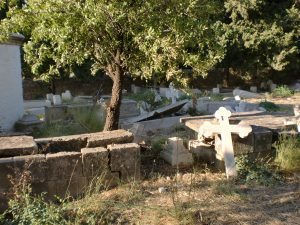 (the Turkish side), the Greek graveyards may have been destroyed deliberately as they are all in a devastating state. The situation for Turkish cemetaries in the South of Cyprus (the Greek side) is different, he says. This raises questions about why this is the case and M. Thorsten Kruse comes – roughly – to conclusions as I formulated in
(the Turkish side), the Greek graveyards may have been destroyed deliberately as they are all in a devastating state. The situation for Turkish cemetaries in the South of Cyprus (the Greek side) is different, he says. This raises questions about why this is the case and M. Thorsten Kruse comes – roughly – to conclusions as I formulated in 
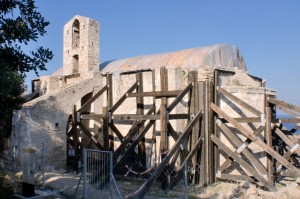
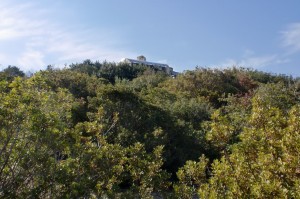

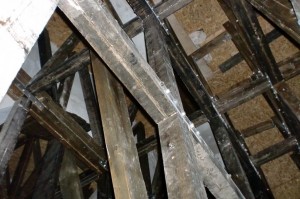






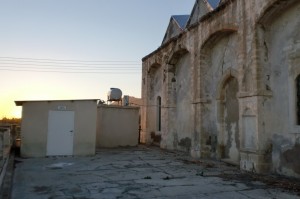

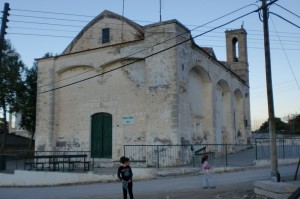
 as the picture here shows. The clock itself is still there but seems to have fallen down and rest on the wall sides.
as the picture here shows. The clock itself is still there but seems to have fallen down and rest on the wall sides.

 In
In 

